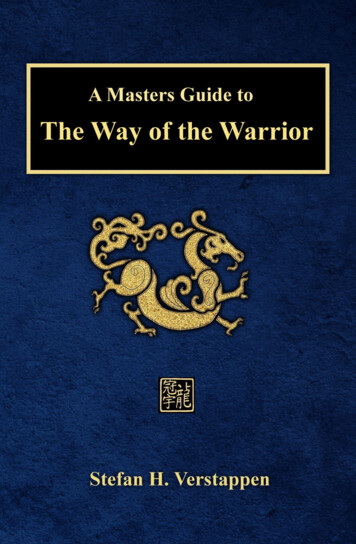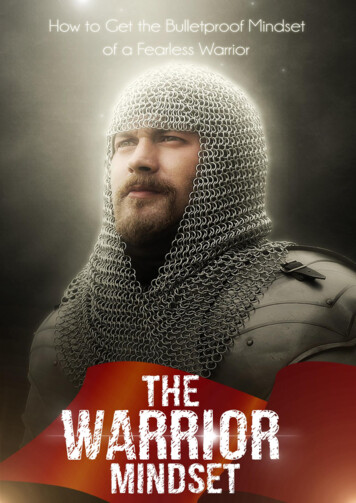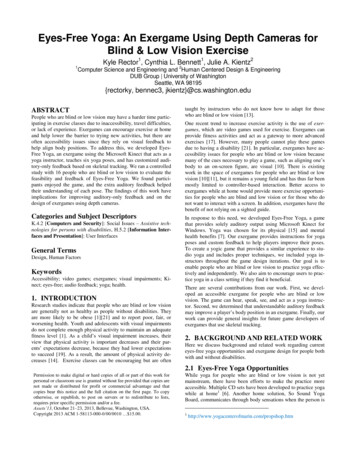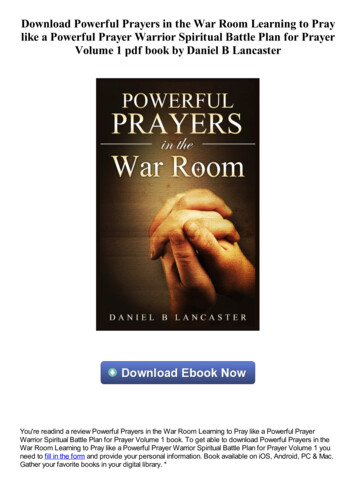
Transcription
A Masters Guide toThe Way of the WarriorBy Stefan H. Verstappen
Cover Design: S. VerstappenAll Illustrations by S. VerstappenCopyright 2016 by Stefan H. VerstappenAll rights reservedISBN-13: 978-1533615336ISBN-10: 1533615330The author of this book does not dispense medical advice orproscribe the use of any technique as a form of treatment forphysical or medical problems without the advice of a physician.The author does not assume any responsibilities for injures thatmay occur in pursuing certain exercises. Please consult aphysician before engaging in any of the physical exercises.Toronto, Canada
A Masters Guide toThe Way of the Warrior
Table of ContentsFoundations. 9Introduction . 1What is the Way of the Warrior? . 5The Dark Knight . 8The Mystic Warrior. 13The Warrior as Shaman. 19The Warrior in the Modern Age. 29The Warrior in the Future . 31The Current Age . 33Principle Practices . 35History and Culture . 43The Origin of Shaolin . 45Northern and Southern Shaolin . 51Wu Tang Shan. 53Tai Chi Chuan . 56Provincial . 57Shaolin Origins of Foreign Styles . 58Warring States . 60Secret Societies and Their Legacy . 62Rural Cultural Traditions . 65Modern Kung Fu Culture . 66Internal . 71The Dragons Pearl . 73Model of the Nervous System . 74Awareness and Perception . 77Focus . 92No-Mind. 103Visualization . 105Sensory Enhancement . 111Vision . 115Hearing. 131Olfaction . 139Balance. 147
The Mysterious Senses. 154Breathing . 161Calming Breath . 167Energy Breathing . 168Rhythmic Breathing . 168Bamboo Breathing . 170Abdominal Breathing . 171Energy . 173External Energy . 174Internal Energy. 176Relaxation . 185Controlling Tension . 187Classical Conditioning . 188Releasing the Bowstring . 190Systematic Muscle Relaxation . 190Riding the Wave . 192Slaying the Two Demons . 195Pain . 197Fear . 208Anger. 219Defending Against Aggression . 222Calming Your Own Anger . 226Leadership . 229Principles of Moral Leadership . 232Principles of Immoral Leadership . 247External . 257Grounding . 259Stance . 260Horse Stance Training . 262Silk Reeling . 263Tai Chi Walking . 266Posture . 269Movement and Form . 275Keys to Understanding Forms . 278How to Learn Forms . 287
Dancing the Wu Shin . 291The Five Animal Styles . 295Tiger . 298Crane . 300Snake . 303The Leopard . 306The Dragon . 309Hand to Hand Combat . 311Striking. 312Fighting Stance . 315Blocks and Parries. 317The Centerline Theory . 319Evasion. 321Grappling . 323Throwing . 324Principles of Combat . 329Guard Position . 329Focus . 331Distance . 332Consciousness . 334Telegraphing . 336Timing . 338Pain and Injury During Combat . 340Combat Strategy & Tactics . 341Combat Exercises . 348The Tools of War . 361Anatomical Weapons . 362Classical Weapons . 370Firearms . 374Defense against Weapons . 378Conclusion . 385The Warrior’s Code . 389Dokkōdō, The Way of Walking Alone, . 389The Eight Virtues of Bushido . 391Glossary of Martial Arts Styles . 393
Bibliography . 395Index . 407About the Author . 419Other Books by Stefan Verstappen . 420
Foundations
IntroductionIntroductionEach one of us must make his own true way, andwhen we do, that way will express the universalway.Shunryu Suzuki, Zen Mind, Beginner's MindThere is an important distinction between martial arts andsimply fighting. The distinction is that traditional martialarts originated as part of a total system of training, theultimate aim of which was a transformation of thepractitioner.Learning to fight is relatively simple; a number oftechniques for defending against, and inflicting, injury islearned and practiced until effectiveness is achieved.Learning to fight is, in terms of psychomotor skills, on apar with learning to drive a car. Conversely Zen, Taoist,1
A Masters Guide to The Way of the WarriorYogic, and several other schools of thought treat martialarts as part of a system of moral, physical, intellectual, andspiritual discipline, one by-product of which was the abilityto defend oneself.In these schools martial arts were treated as a tool to attaingoals prescribed by religious institutions such as the Zengoal of enlightenment (Satori) and the Taoist goal ofimmortality, psychic powers, or Wu Wei (going with theflow).Examples of schools of philosophy that incorporate martialarts as part of their curriculum are not confined to the FarEast.For example, the medieval Spanish schools of fencingoffered a five-year program that combined the training ofbroadsword, rapier, saber, foil, spear, and halberd, withintensive study of mathematics, geometry, astronomy,philosophy, and history. Part of the training programincluded the practice of complex routines (Kata) that wereperformed on a geometric grid pattern carved into the floor.Graduates from the Spanish schools were renowned fortheir detached and dispassionate composure during battle,much like the Japanese samurai.Other examples include the Knights Templar an order thatcombined both strict religious observances with fiercemilitary training. On the one hand renowned for their2
Introductioncharitable work, they werealso both feared and admiredby their enemies.Although classical literatureon the martial arts emphasizethe necessity of spiritual andmoral development, fewschools of martial arts today pay enough, if any, attentionto this area of study. Conversely, the occasional school thatdoes attempt to teach the philosophic side tends to delveinto fantasy often neglecting the sweat and blood trainingthat is vital to achieving real skill.If one is to study a martial art, as an art, then it shouldinclude study of the arts, sciences, and humanities. Thisidea was first expressed by the Confucian ideal of the Gentleman' (Chun Tzu).Confucius wrote that a gentleman was required to studyliterature and philosophy, painting, history, music, andmartial arts. According to Confucius, the problems of manand society stem from selfishness, greed, and ignorance.He taught that in order for people to live in harmony withnature, society, and each other, every person must make anindividual effort to overcome selfishness and ignoranceand to live life according to a personal code of conduct.Such a person would be known simply as a gentleman.Those who would be leaders were held the mostaccountable and had the responsibility for setting anexample.Since following the path of the gentleman was difficultConfucius included the practice of martial arts to develop3
A Masters Guide to The Way of the Warriorthe strength, courage, and self-discipline needed to becomea gentleman.It is the aim of this work to provide information thatstudents of the warrior path can apply to all forms of art.4
What is the Way of the Warrior?What is the Way of the Warrior?One who excels as a warrior does not appearformidable;One who excels at fighting is never roused toanger;One who excels in defeating his enemy does notjoin issue;One who excels in employing others humbleshimself before them.This is known as the virtue of non-contention.Lao Tzu, Tao Te ChingThe phrase ‘the Way of the Warrior’ has its origins ineastern philosophy and a meaning that is complicated toexplain.5
A Masters Guide to The Way of the WarriorTo understand what this phrase entails, and hence, whatthis book is about, let us break down the concept by theircomponent words.The Way: The term ‘Way’ is the English version of theancient Chinese word Tao or Dao. The word Tao firstappears in the 4th century BC text known as The Tao TeChing (Dao De Jing) "The Book of the Way of Virtue."reputedly written by the legendary founder of Taoism, LaoTzu. This relatively short book is one of the mostinfluential writings in Chinese, and by extension, Japaneseand Korean, spiritual thought.Many scholarly volumes have been written to try to explainthe philosophy espoused in the book but to capsulize, withthe resulting loss of textual meaning, one could describethe basic principle of the book as follows.The Tao (Way) is the source of the universe and all itsmyriad facets. It functions and moves in way that cannot bedescribed, but must be experienced intuitively. Through thedirect experience of the universal principle, one is inharmony with nature. This harmony is called virtue.(Another term with multiple meanings in Chinese thought.)In the 2500 years since the word Tao first appeared, itsmeaning has undergone some additions and alterations.Add to the original meaning, the concepts of following apath, a way of living or experiencing life, a means to attainspiritual perfection, and a close associated with theuniversal life force call Chi, an important principle in bothTaoism and martial arts.The Warrior: There are two standard dictionary meaningsgiven for, the term "warrior.” The first refers to "a manengaged or experienced in warfare." The second refers to"a person who shows or has shown great vigor, courage, or6
What is the Way of the Warrior?aggressiveness, as in politics or athletics." The term"warrior" is often associated with images of power,confidence, accomplishment, integrity, chivalry, honor, andintegrity.This is a western definition and to understand the word‘warrior’ according to its eastern interpretation, we mustmake a certain distinction between a warrior and a soldier.A soldier's usefulness lies in his ability to act within agroup as part of a greater whole, a team player. A soldierexecutes the decisions, is subject to the laws, and fights thebattles designated by an elite power structure. Finally, asoldier is not responsible for his actions, moralresponsibility is transferred up the chain of command. Asoldier is only following orders, and thus, not morallyresponsible for his actions.Conversely, a warrior is an individualist whose usefulnesslies in his own initiative and innovation. He obeys a codeof moral conduct that supersedes, and may, or may not,conflict with the existing legal codes. The warrior makeshis own decisions on when, where, and with whom to dobattle. Finally, a warrior assumes full responsibility for hisactions.Ultimately, a soldier is a tool of the state and a warrior isan anarchist - someone who neither follows orders, norseeks to give orders to others. 11 In the original meaning of the word, "one without rulers".Anarchists generally believe that human beings are capable ofmanaging their own affairs on the basis of creativity, cooperation,and mutual respect, without the need for the violent imposition ofgovernment laws.7
A Masters Guide to The Way of the WarriorThus far, we can say that the Way of the Warrior is aspiritual path of being in harmony with the universe whilecultivating the qualities of courage, chivalry, honor, selfreliance, critical thinking, and the skill to defend against,and employ, violence.It is the last descriptor that many people find worrisome.How can a spiritual path involve violence?Well then, the accomplished man uses the swordbut does not kill others.He uses the sword and gives others life. When itis necessary to kill, he kills.When it is necessary to give life, he gives life.Takuan Soho, Letters to Yagyu MunenoriThe Dark KnightOne reason for a warrior to have courage is so that he canface the violence inherent in this world. Nature is bothbeautiful and cruel. We all try to avoid this unpleasant truth.While we enjoy an outdoor Barbeque how many couldstomach a visit to the slaughterhouse? We admire thegraceful strength and beauty of a lion, but turn our headswhen it slowly tears apart a baby springbok. While wepraise our soldiers, how many want to know the details ofthe horrific acts they committed on innocent people for our‘freedom’?We can run and hide from cruelty and violence, but if thereis nowhere to run to, and nowhere to hide anymore, whowill turn to face the darkness?This is why the path of the warrior is so difficult, and sonecessary. Without warriors among a population, thatpopulation becomes a herd, and like all herds, inevitablyled to slaughter.8
What is the Way of the Warrior?There are times and conditions in every society andeveryone’s life where one must face danger and conquer it.Only a warrior can hope to succeed. While the otherspiritual paths offer many benefits to those that followthem, they are useless against the dark side.Someone who spent years mastering meditation sitting inthe forest, would quickly find himself immersed in a worldof pain, confusion, and panic the first time he is punched inthe nose.While everyone can benefit from following many of theways and means of the warriors’ path, and integrate theminto one’s own personal path, to become a warrior onemust include some practical combat training. This couldrange from a self-defense course, to regular training in themartial arts and even other sports such as target shooting,archery, and fencing. Previous experience facing dangerand violence is essential.A time to kill and a time to heal, a time of warand a time of peaceEcclesiastes 3:1-8A Time to KillModern religions from Christianity and Islam, to Buddhismand Taoism, and even the modern New Age movement,were founded and rose to prominence under tyrannies anddictatorships.It should be understood that the psychopathic rulers ofancient times, to the psychopathic rulers of today, wouldnever allow religious movements to become established, letalone flourish, if they posed a threat to the existing powerstructure.9
A Masters Guide to The Way of the WarriorHistory is rife with religious persecutions, book burnings,and mass slaughter of devotees. The endless bloodshed hadnothing to do with god or spiritual enlightenment, andeverything to do with tyrants perceiving religiousmovements as a threatMost religions began as revolutionary movements thatwere antithetical to the empire of their day and were thuspersecuted in their early days. However, in order to survive,each religion adapted itself to the needs of their empiresand evolved to support the power structure, rather thanpreach against it.One way in which these movements adapted to tyranny isthrough the ideal of non-violence, but only when it suitedthe empire. When the empire needed soldiers, then all thereligious platitudes of peace and non-violence were thrownout the window and replaced with wartime propagandaencouraging young men to murder in god’s name, and forthe profit of the psychopaths in charge.During peacetime, the religious rhetoric returns to itspacifist default. The result is that all spiritual movementsand paths emphasize non-violence and non-aggression.While these ideals may sound ennobling, there is a glaringweakness that is the result of not understanding natureitself - that it is essentially violent.The non-aggression principle is foolhardy and selfdefeating in societies that have been infected withpsychopaths, psychopaths that inevitably come to dominateevery power structure precisely because they have noqualms about violating this principle.10
What is the Way of the Warrior?While the worst specimens of humanity reap lavishrewards in the material world, the state religions tell theirvictims that their reward awaits them in the afterlife.Promoting non-violence as the highest principle of spiritualdevelopment is akin to teaching rabbits not to run whenthey see a fox.Ironically, some violence is condoned as long as thatviolence is directed at oneself - martyrdom.For most of us, the idea of sacrificing one’s life for a causeis far easier to contemplate than killing for a cause.Religious programming glorifies those that die for theircause as martyrs, but only those that kill on behalf of thestate are lauded as heroes. Those that kill for a cause,contrary to the state’s agenda, are terrorists.So the common conception that a spiritual path must benon-violent is based on state and religious indoctrination toinsure their hold on power and authority.This undermining the warrior spirit has reached suchabsurd levels that in most countries in the world it is illegalto defend oneself from attack. Every species on the planethas the means and intrinsic right to protect itself, yetgovernments have denied their citizens both the means andthe right, an abomination against nature.A warrior must reclaim the natural right to defend himselfagainst both individual and organizational predation.There is another important reason why a warrior must beable to use violence that touches on the level of the spirit.11
A Masters Guide to The Way of the WarriorIn a battle for survival between two opponents, the fighterwho is mentally ready and committed to killing hisopponent has a huge advantage.This advantage is so big that differences in size, numbers,or weapons are secondary.In any war, the readiness to suffer and die, aswell as to kill, represents the single mostimportant factor. Take it away, and even the mostnumerous, best organized, best trained, bestequipped army in the world will turn out to be abrittle instrument.Martin Van Creveld, The Transformation of WarThere is an irony in that the mental willingness to inflictviolence decreases the likelihood that one would have to.This is a subtle yet immensely effective component ofThreat Display Behavior. (See Anger)Animals settle disputes with what is called threat displaybehavior. This includes showing the teeth, puffing up,raising the hair and other actions designed to make theanimal look fierce and formidable. Rarely do animals ofthe same species come to blows, instead, one rival submitsto the threat display of the other.Humans also use threatening displays to intimidate rivals.Posturing, yelling, staring, stomping and punching the airare typical threat display behaviors humans share withprimates. However, a calm and cold intent to kill trumpsthese displays.There is an instinctive understanding or some psychictransference that all but the most intoxicated fool willnotice. This message is often enough to dissuade any attack.12
What is the Way of the Warrior?Thus, the willingness to use violence is the best deterrent toviolence.If one’s opponent is, however, a psychopathic criminal,who is equally intent on using violence, then, only yourown willingness to kill can save you.A warrior understands that humans are apex predators.While other predators prey on a limited number of species,humans prey on every species on the planet, including itsown. The enemies of humanity have no hesitation tomurder millions of innocent men, women, and children.Violence is an ugly and dirty business and rightly repulsesgood and decent people. However, a warrior mustovercome his own revulsion to violence and familiarizehimself with it, and learn how to use it. Not to do so wouldguarantee defeat in every battle.Without self-knowledge, without understandingthe working and functions of his machine, mancannot be free, he cannot govern himself and hewill always remain a slave.G.I. GurdjieffThe Mystic WarriorThere is another layer we shouldadd to our understanding of thewarrior’s path; the Way of theMystic WarriorMysticism and martial arts havebeen linked together since ancienttimes and the resultant archetypeknown as the mystic warrior is apart of every culture.13
A Masters Guide to The Way of the WarriorMuch of Taoist and Buddhist philosophy can be tracedback to India and the Yogic traditions. The Hindu writingsspeak of four spiritual paths (each one complex and withmany variables) they are:The Way of the Fakir (Hatha Yoga)The fakir works to obtain mastery of the attention throughstruggles with controlling the physical body involvingdifficult physical exercises and postures.The Way of the Monk (Bhakti Yoga, Karma Yoga)The monk works to obtain self-mastery through strugglewith controlling the affections, in the domain of the heart.The Way of the Yogi (Jnana Yoga)The yogi works to obtain mastery through struggle withcontrolling mental habits and capabilities.The Fourth Way (Raja Yoga)This is a comprehensive path encompassing all of the threeprevious paths.The three paths are based on the theory that humans havethree brains or centers. (Similar to the Yogic concept ofChakras.) These centers and their corresponding paths arecalled: Intellectual (The Way of the Yogi)Emotional (The Way of the Monk )Moving/Instinctive (The Way of the Fakir).Each center has certain functions. The intellectual center isresponsible for functions such as mathematics, engineering,philosophy, and contemplation. Emotional center isresponsible for feeling, poetry, art, music, love, anddevotion. Moving center is responsible for instinct,physiological functions, breathing, and movement.14
What is the Way of the Warrior?The theory that man has three centers or brains is ancient inorigin and long associated with the study of the meanstowards spiritual development. Modern research into brainstructure corroborates this theory. The brain can be dividedinto three parts known as the old, mid, and new brain.The old brain, or reptilian brain, the oldest of the three,controls the body's vital functions such as heart rate,breathing, body temperature, and balance. Our reptilianbrain includes the main structures found in a reptile's brain:the brainstem, the pons, and the cerebellum. The old braincorresponds with the Moving/Instinctive center.The mid brain, or limbic brain, emerged in the firstmammals. It can record memories of behaviors thatproduced agreeable and disagreeable experiences, so it isresponsible for what are called emotions in human beings.The main structures of the limbic brain are thehippocampus, the amygdala, and the hypothalamus. Thelimbic brain corresponds to the emotional center.Finally, the new brain, neocortex, is the most recentevolutionary development and first assumed importance inprimates and culminated in the human brain with its twolarge cerebral hemispheres that play such a dominant role.These hemispheres have been responsible for thedevelopment of human language, abstract thought,imagination, and consciousness. The neocortex is flexible15
A Masters Guide to The Way of the Warriorand has almost infinite learning abilities. The neocortex iswhat has enabled human cultures to develop andcorresponds to the intellectual center.It is said that everyone will have an affinity for, andfunction primarily in, one of the three centers. Some peopleare more intellectual, some more emotional, and somemore athletic, and those that are inclined to seek spiritualdevelopment will therefore be drawn to one of the threepaths.The early 20th century Russian mystic, philosopher, andspiritual teacher G.I. Gurdjieff insisted that these paths although they may intend to seek to produce a fullydeveloped human being - tend to cultivate certain facultiesat the expense of others. The goal of religion or spiritualitywas, in fact, to produce a well-balanced, responsive andsane human being capable of dealing with all eventualitiesthat life may present. Gurdjieff therefore made it clear thatit was necessary to cultivate a way that integrated andcombined the traditional three ways.The Fourth Way therefore seeks to master the mind, heart,and body, simultaneously. That the Way of the Warrioralso follows the Fourth Way can be seen in the writings ofgreat warriors themselves.Confucius bemoaned t
The Way: The term ‘Way’ is the English version of the ancient Chinese word Tao or Dao. The word Tao first appears in the 4th century BC text known as The Tao Te Ching (Dao De Jing) "The Book of the Way of Virtue." reputedly written by the legendary founder of Taois











